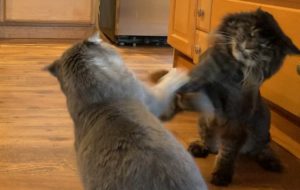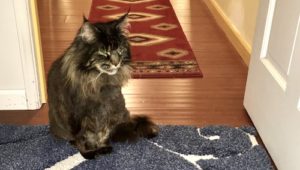
If your cats get along well, they will share sleeping areas, engage in some allogrooming, and greet each other on occasion by touching noses. Well, you say, my cats aren’t very good friends but they aren’t trying to kill each other, either. What are the signs of conflict? What should we look for to avoid getting to the point “they want to kill each other”?
The 2020 survey referred to in last week’s post not only assessed affiliative behaviors, they also polled respondents on conflict behaviors. They chose seven behaviors associated with conflict. These are listed below with the frequency reported by the participants of the survey. (Elzerman AL, DePorter TL, Beck A, Collin JF. Conflict and affiliative behavior frequency between cats in multi-cat households: a survey-based study. J Feline Med Surg. 2020 Aug;22(8):705-717. doi: 10.1177/1098612X19877988)
| Behavior | Frequency | Rank |
|---|---|---|
| Stare | daily | 7 – Most frequent |
| Stalking | daily | 6 |
| Chasing | daily | 5 |
| Running away | weekly | 4 |
| Twitching Tail | weekly | 3 |
| Hissing | monthly to never | 2 |
| Wail/Scream | monthly to never | 1 – Least frequent |
How do your Cats Get Along?
Let’s take a closer look at these conflict behaviors.
THE STARE
A cat will stare without blinking:
- at prey while hunting – he is aware of where that animal is and what it is doing, otherwise he may miss out on dinner!
- during a cat fight. Fighting cats must be able to rapidly respond if the other launches an attack.
- to discourage another cat from accessing a resource.

If you see one of your cats fixing an unblinking stare on another, take note of the circumstances and see what happens if you intervene. For example, if one cat is staring at another cat and is sitting in a doorway, she may be blocking the other from resources through that doorway.
Interrupt the stare by opening the door wider, throwing a treat away from the doorway, or redirecting the “door-blocker” with a toy. Does this give the other cat a chance to get through the doorway? If this is successful, you may want to look more closely at how these two cats get along.
Avoid handling the cats in this situation in case they are more aroused than they appear.
Stalking, Chasing and Running Away
These behaviors may be associated with:
- hunting
- fighting
- cats playing together
When hunting, the cat is targeting a toy or prey. It is object play. But how do we know whether two cats are fighting or playing? After all, many of the same moves in a cat fight are seen when cats play together.
Just like a football game, play between cats has distinct rules. And, like football, tempers may flare when a player challenges the rules. What starts as play can escalate into a cat fight.
invitation to play

play sequence

end of play

Are these cats playing?
Social play consists of an invitation to play, the play sequence, and the end of play. The rules are:
- Claws are not extended
- Biting is gentle without intent to injure
- The invitation to play is often repeated by one or the other of the cats throughout the interaction.
- If one cat declines play (there may be some hissing and growling here), the game ends.
If you see that the “rules” are not being followed, it is time to shake a bag of treats or can of coins and redirect or separate the participants. [see Managing the Indoor Cat Fight].
Check all your cats regularly for wounds from bites and scratches. If you notice your cats having a lot of wounds from scratches or bites and they “play” together, this may not be play. It may be conflict and it is time to observe the cats, assess their environment and social status.
Twitching Tail
A twitching tail indicates that a cat is focusing on something. The tail is for balance and changing direction – the tail often twitches before the cat pounces.
- The twitching tail + stare > pounce: Is this play? conflict?
- Are the rules of play being followed?
A map of the social groups in the house can help with deciding whether this is play or conflict.
Vocalizations – Hissing
The hiss is that snake-like sound. Cats may hiss when they are:
- afraid
- startled
- frustrated
- displeased
- You will hear it in a cat fight, often from the cat on the defensive.
Vocalizations – Wailing/Screaming
Cats will wail or scream:
- if they are fearful
- if they are hurt and in pain
- if they are fighting
You must decide from the circumstances and the body language of the cat or cats if these vocalizations are meaningful. If it is a cat fight, the combatants must be separated [managing the indoor cat fight]; if a cat is hurt, you must get the cat in a box or carrier for a trip to the vet.
Don’t wait for a fight to break out. Take a few moments to determine if your cats get along and if there is anything you can do to improve things.
- Map social groups [Social Groups of Cats]
- Draw a house map of resources (litter boxes, food stations, water, scratchers). Draw paths showing how cats reach these resources.
- Move furniture if necessary to make accessing resources easier for all cats.
- Make sure there sufficient resources for the number of cats.
Next week, we’ll take a look at describing individual cats’ personalities. How does this affect how cats get along?

